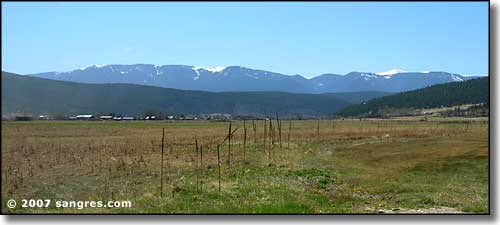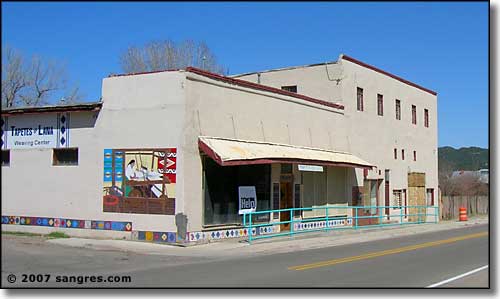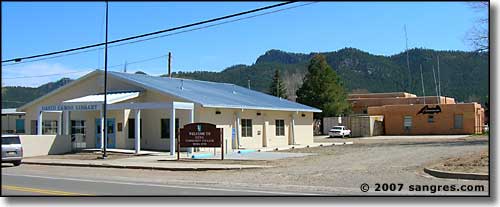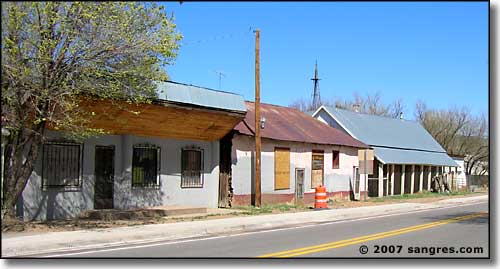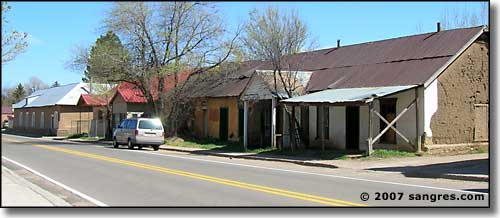
From the time when Juan Bautista de Anza made his successful sortie to end the Comanche raids on northern New Mexico in 1779, folks had been living on the east side of the Sangre de Cristo's without worrying about legal title. Then in 1835, 76 Anglo and Hispanic men, mostly from Las Trampas but also from Embudo and Picuris, were given grants of land in the Mora Valley. Some of the men were single but quite a few were married and brought their families with them. They were trappers, hunters, mountain men, and sheep herders. Those who put their minds to it became quite prosperous in Mora.
In 1843, a group of Texas freebooters under the command of Colonel Charles A. Warfield raided Mora on the pretext that the local folks had bought stolen Texas beef from the Comanches. In the raid they killed 5 men and took 18 women and children as captives, plus 75 horses, for the journey back to Texas. The people of the valley put together a posse and chased them down, retrieving their women, children and other stolen property and sending the Texans back to Texas on foot. This whole charade by the Texans was part of the plan to get the Mexican War started (which finally happened in 1846).
In 1847, the Taos Uprising occurred, in Taos and in Mora. American troops fought Hispanic insurgents at the Battle of Mora and when the fighting was over, the Union Army looted and burned the town, the nearby ranches and all the crops, to the ground. Along the way they killed any locals (including women and children) they came across. After the army left, the local folks who'd fled the fighting returned and rebuilt. After Fort Union was established in 1851, the military bought a lot of their food supplies from these same Hispanic settlers.
An interesting fact is that Alexander Barclay, owner of the Scolly Grant, sued the Army in court in Santa Fe to force them to pay rent for the land they built Fort Union on. The Army lost the suit and paid Barclay $1,200 per year in rent. Years later it was discovered that Fort Union had been built on Mora Grant land, and not on Barclay's property.
In 1853, Ceran St. Vrain settled in Mora, built a grist mill and became one of the primary suppliers of fodder, grain and flour to Fort Union. At its peak, Mora had 5 different grist mills operating to supply the fort.
The common lands of the Mora Grant were sold for back taxes to "The State Investment Company" on the county courthouse steps in 1916. That cut off the people's access to timber and grazing that they had enjoyed since 1835 (this is one of those things that had been guaranteed to the people by the treaty of Guadalupe-Hidalgo which ended the Mexican War - and the American government reneged on its solemn written promise). At that point, the population of Mora began to dwindle.
As each of the original settlers had personally been given rights to the land, there was never an official town site defined. To this day, there is still no official "Town of Mora." Out of necessity, the business and governmental area that we now know as Mora built up over the years but that layer of civic bureaucracy (and taxes and regulations) doesn't exist. The folks who live here now are intelligent enough to make sure that it won't exist in their lifetimes either (you can tell I'm a big fan of government, politicians and bureaucracy).
The valley is gorgeous, especially with that backdrop of the Sangre de Cristo's. I took these photos in early April on a beautiful day (there were a lot of folks out on their Harley's that Friday). The streams were full but the trees hadn't begun to bud yet. I found several llama and alpaca ranches around town and quite a few church camps up against the National Forest (this is very close to the Pecos Wilderness).
